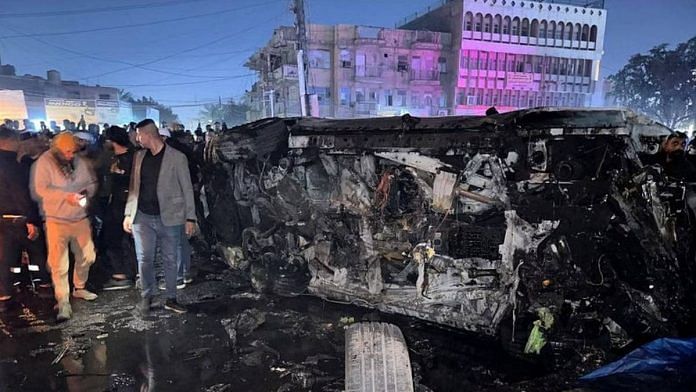The United States and Israel have reportedly launched several targeted assassination operations since the outbreak of the Gaza War on 7 October 2023. The most recent involved the use of a ‘flying Ginsu’, a modified Hellfire missile fitted with six blades, against Abu Baqir al-Saadi, leader of the Kataib Hezbollah, for his role in killing US soldiers.
Although weapons of choice have become increasingly sophisticated, such assassinations have been a tool of statecraft throughout history. Despotic rulers, tyrannical monarchs, and repressive political leaders have all been targeted in pursuit of political interests. Similarly, military leaders have been neutralised to obtain favourable outcomes in wars. In ancient Greece, several city states authorised and rewarded such actions to defend democratic rule, while in 15th and 16th century Europe, targeted assassinations were widespread and morally acceptable.
While there have been calls to ban such operations, these have not had much success. In the US, the Abraham Lincoln administration ordered Union Forces to refrain from assassinations, and later, in 1963, President Gerald Ford issued Executive Order 11905, prohibiting government employees from engaging in political killings. However, the practice continued through the Cold War, with both blocs targeting government officials, dissident leaders, lawyers, and investigative journalists, often through proxies.
Also Read: Ukraine has fired its military chief at the wrong time. Russia will exploit this instability
‘Flying Ginsu’ to AI-powered machine guns
The Global War on Terror witnessed technologically advanced platforms and systems used for such operations. The ‘flying Ginsu’, or AGM-114R-9X, a CIA-developed variant of the Hellfire air-to-ground missile, became a weapon of choice in drone strikes against terrorist leaders. The Hellfire R9X was originally developed as an anti-tank missile, with variants featuring blast fragmentation and thermobaric warheads. However, to reduce collateral damage in counterterrorist operations, the explosive warhead was replaced with six stainless-steel blades that deploy just before impact with the target. The missile is extremely accurate with a lethal zone of 30 inches, serving the goal of minimising collateral damage.
With the development of newer technologies there has been a transformation in the conduct of such operations. For instance, a satellite-controlled machine gun with ‘artificial intelligence’ was reportedly used to assassinate Iran’s leading nuclear scientist, Mohsen Fakhrizadeh, on 27 November 2020. Remarkably, the scientist’s wife, who was sitting just 10 inches away in the same vehicle, was unharmed. The machine gun used in the operation was reportedly mounted on a Nissan pickup and was remotely operated using multiple cameras. Additionally, AI software was reportedly used to factor the relative speed of the two vehicles and the shaking of the truck when the bullets were fired. Thirteen bullets were fired when the vehicle carrying the scientist reached a U-turn, killing him and his guard. Israel, which has been blamed by Iran for the attack, has neither confirmed nor denied its involvement.
In the absence of any concrete evidence, this operation may seem to be in the realm of fantasy. However, rapid technological advancements may see a more frequent employment of such systems in the not-so-distant future.
Also Read: Gains from covert killing come with a big price tag. India can learn from Chile
Setting a ‘high price’ for terror?
Israel has unabashedly pursued a policy of neutralising ‘terrorists’ who have allegedly harmed its people or interest. The guiding principle of this approach was perhaps outlined in a July 1955 lecture by Moshe Dayan, then Chief of Staff of the Israel Defense Forces (IDF). Titled ‘Retaliation Operations as a Means of Ensuring Peace’, the lecture to IDF officers sent a clear message: “We cannot always prevent the murder of workers in an orchard or sleeping families, but we can set a high price for our blood. A price too high for the Arab settlement, the Arab army and the Arab government to pay. … [Retaliation operations] are not for vengeance. It is an act of punishment and warning, that if that state does not control its population and does not prevent them attacking us – the Israeli forces will cause havoc in its land.”
What do countries hope to achieve from such operations? What are the objectives and the long-term consequences? Does the neutralisation of terrorist leaders lead to the demise of the organisation or even diminish their ability to conduct terrorist acts in the long run?
There are studies that suggest terrorist groups depend on the charisma of their leaders, making them seemingly irreplaceable. However, such studies may overemphasise the difficulties of leadership succession, as evidenced many times, including in the case of al-Qaeda. It has also been argued that the terrorist group is weakened when a leader with both operational and inspirational roles is eliminated. However, over time, terrorist groups have been observed to become functioning bureaucracies, with their own systems and processes, making them resilient to such attacks.
So, why do governments persist with such operations?
As Moshe Dayan said over six decades ago, a message needs to be sent—either you control your people or we will be forced to do so, in the hope of reducing terrorist actions.
Col (Dr) Rajneesh Singh (Retd) is a Research Fellow at MP-IDSA, New Delhi. Views are personal.
(Edited by Asavari Singh)



